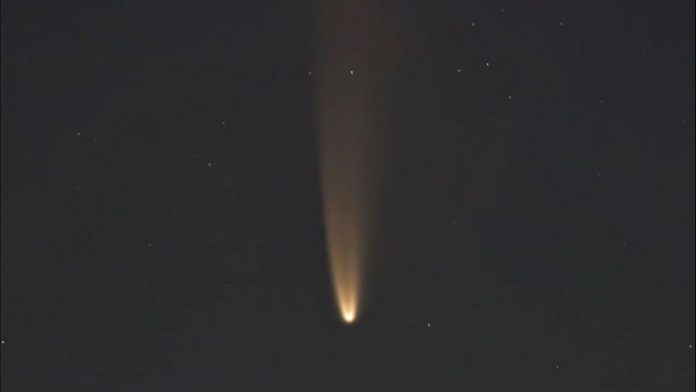A spectacular image of the Comet C/2020 F3 NEOWISE above Rome, Italy, at dawn with the International Space Station (ISS) crossing the field of view has been published an astronomer.
Gianluca Masi, with the Virtual Telescope Project (VTP), captured the scene on July 7 over Janiculum Hill in the Eternal City, facing northeast, after around 3:30 a.m. local time.
The comet is now bright enough in magnitude that skilled observers with pristine skies are reporting they have seen it with the naked eye.
“It was very obvious to see by naked eye, below Capella, one of the brightest stars up there, now in the northeastern sky at dawn,” Masi told Newsweek.
Writing on the VTP website, he said: “I started imaging minutes after the comet had technically risen and it was there! I could not believe it: the comet was visible in my images, while it was very low above the horizon.
“I cannot tell you the emotion which exploded in my heart! Many years [have] gone since the last time we spotted a naked eye comet from the city of Rome. I was 23 years younger the last time I saw a comet so easily. I almost cried.”
The comet from 23 years ago that Masi referred to is Comet Hale-Bopp, which was dubbed the Great Comet of 1997. This very bright comet remained visible to the naked eye from Earth for a record 18 months.
As an additional bonus, Masi was also able to capture the ISS, which happened to be moving across the same part of the sky, using a combination of several images. The astronomer said his observations ended when the rising sun eventually rendered the comet invisible for the day.
Astronauts and cosmonauts aboard the ISS have also managed to snap some spectacular pictures of Comet NEOWISE in the past few days, including Russian crew member Ivan Vagner who described the comet as the “brightest one over the last 7 years.”
На следующем витке попробовал чуть ближе сфотографировать самую яркую за последние 7 лет комету C/2020 F3 (NEOWISE).
Довольно хорошо видно ее хвост из космоса, с борта Международной космической станции!#МКС #комета #NEOWISE pic.twitter.com/zo7INtT01l
— Ivan Vagner (@ivan_mks63) July 4, 2020
The comet was even featured as NASA’s Astronomy Picture of the Day on Tuesday—a dramatic image showing the object over Lebanon.
The object, which was first spotted by NASA’s NEOWISE space telescope on March 27, 2020, brightened as it reached its closest approach to the sun on July 3. It is now moving closer to Earth on its way back toward the outer solar system in its long orbit around our star.
Even though the comet may be visible to the naked eye, astronomers recommend using binoculars to spot the object. These can be removed once the object once you have located in order to try and see it unaided.
“It is always better to observe comets with optical aid, especially a pair of binoculars and to seek dark rural skies, away from light polluted cities,” Michael Mattiazzo, an amateur astronomer who has discovered eight comets, told Newsweek.
In the northern hemisphere, the comet should be easily visible through binoculars at early dawn for the next few days above the northeastern horizon. By mid-July, the comet will become readily visible low in the northwestern evening sky from the northern hemisphere, according to Mattiazzo.





























